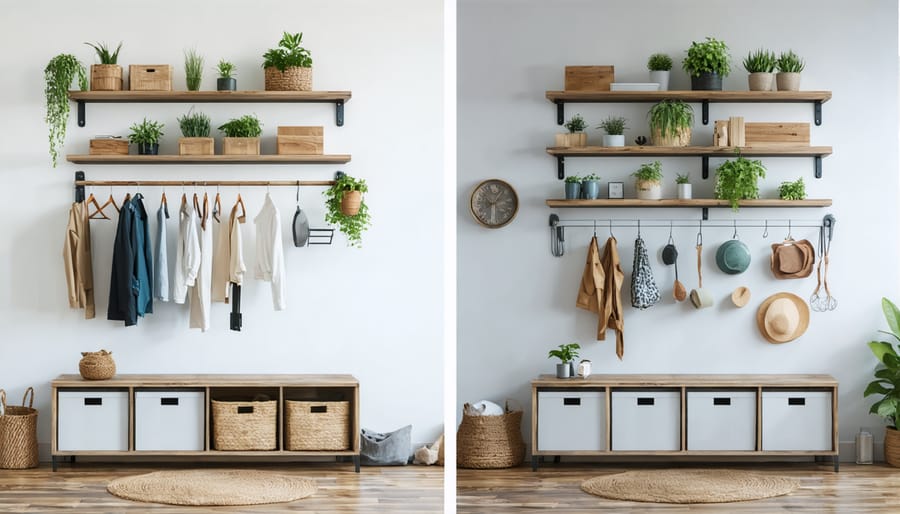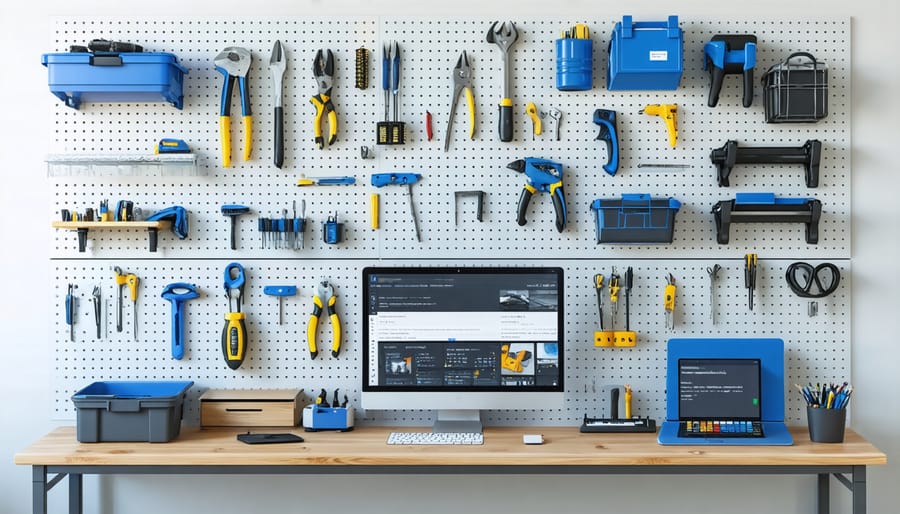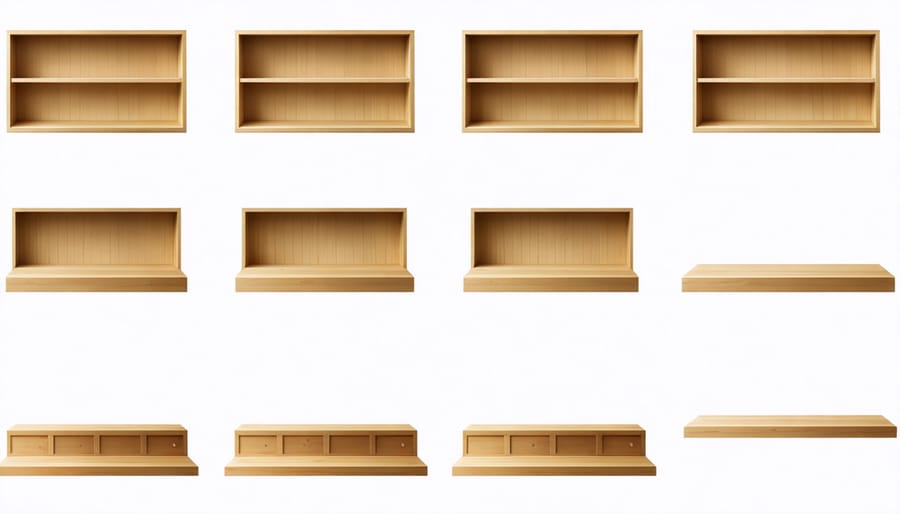Transform your cramped living quarters into a spacious haven by mastering the untapped potential above your head. Look up, and you’ll discover an entire dimension of storage and design possibilities waiting to help you maximize your living space. From floating shelves that create elegant book displays to ceiling-mounted bike racks that free up valuable floor space, vertical storage solutions revolutionize how we think about room organization.
Modern homes increasingly embrace floor-to-ceiling solutions, turning bare walls into functional works of art. Whether you’re working with a cozy studio apartment or a sprawling family home, vertical space optimization offers a smart, stylish way to declutter while adding character to your living environment. By thinking vertically, you’ll unlock square footage you never knew existed, creating breathing room in even the most compact spaces.
This practical guide will walk you through innovative vertical storage strategies that blend seamlessly with your existing décor, proving that the most valuable real estate in your home might just be the space between your floor and ceiling.
Why Your Walls Are Your Best Storage Asset
Space-Saving Benefits
Making the most of vertical space is a game-changer when it comes to storage hacks for small spaces. By thinking upward instead of outward, you can dramatically increase your usable space while keeping your floor area open and clutter-free. This approach is particularly valuable in urban homes where every square foot counts.
One of the most significant advantages of vertical storage is the preservation of valuable floor space. Instead of filling your rooms with bulky storage units, vertical solutions allow you to maintain open pathways and create a more spacious feel. This not only makes your home more comfortable to navigate but also contributes to a more organized and visually appealing environment.
Vertical storage also encourages better organization by creating designated spaces for different items. When you arrange things vertically, it’s easier to see and access everything you own, preventing items from getting lost or forgotten in deep drawers or crowded closets. This visibility naturally promotes better organization habits and helps maintain a tidier home. Plus, the added bonus of keeping items off the floor means easier cleaning and maintenance of your living space.

Room-by-Room Potential
Each room in your home holds unique vertical storage potential. In kitchens, utilize cabinet tops for decorative storage baskets and install hanging pot racks to free up cabinet space. Bathrooms benefit from over-the-toilet shelving units and towel hooks arranged in vertical rows. In bedrooms, consider floor-to-ceiling wardrobes and over-the-door organizers for accessories and shoes.
Living rooms offer opportunities with tall bookshelves, wall-mounted entertainment centers, and floating shelves for displaying decor. Home offices can maximize productivity with vertical file systems and wall-mounted supply organizers. Even small spaces like entryways can transform with coat hooks, shoe racks, and wall-mounted mail organizers.
Don’t overlook garages and utility rooms – vertical bike racks, tool organizers, and pegboard systems can create significant storage space while keeping floors clear.
Practical Vertical Storage Solutions
Wall-Mounted Systems
Wall-mounted systems offer one of the most versatile and efficient ways to maximize vertical space in any room. Shelving units, whether floating or bracket-supported, provide elegant storage solutions that can help you design the perfect workspace or living area while keeping your floor space free.
Pegboards have made a stunning comeback in modern home organization, offering incredible flexibility for storing everything from kitchen utensils to craft supplies. These customizable boards allow you to rearrange hooks, baskets, and shelves as your needs change, making them perfect for evolving storage requirements.
Modular wall systems take organization to the next level, combining various components like cabinets, open shelving, and hanging rods into a cohesive unit. These systems are particularly effective because they can be expanded or reconfigured over time, adapting to your changing storage needs.
When installing wall-mounted systems, always consider the wall type and weight capacity. Drywall requires proper anchoring, while brick or concrete walls might need special mounting hardware. For the best results, use a level during installation and leave enough space between units for easy access to items.
Pro tip: Before mounting any system, create a paper template on the wall to visualize the layout and ensure it meets your needs. This simple step can save you from unnecessary holes and reorganization later.

Door and Behind-Door Solutions
Doors and the spaces behind them offer untapped potential for vertical storage that many homeowners overlook. Over-the-door organizers are versatile solutions that can transform any door into a storage powerhouse. Consider using multi-pocket organizers for shoes in bedrooms, toiletries in bathrooms, or pantry items in the kitchen. The best part? They’re completely removable and leave no damage.
The space behind doors presents another opportunity for smart storage. Install a series of hooks at different heights to create a layered storage system for coats, bags, and accessories. For a more sophisticated look, consider mounting a shallow shelving unit or pegboard that fits within the door’s swing radius. Just remember to install door stoppers to prevent wall damage.
Here’s a pro tip: measure your door’s dimensions and swing arc before purchasing any organizational systems. For bedroom doors, consider installing a full-length mirror with hidden storage compartments – it’s both functional and space-efficient. In bathroom doors, towel bars mounted at different heights can maximize vertical space while keeping towels within easy reach.
For closet doors, magnetic strips can hold small metal items like bobby pins or tools, while wire baskets attached to the door’s interior can store smaller items that might otherwise get lost. Remember to distribute weight evenly when using over-door solutions to prevent straining the hinges.
Corner and Height Maximization
Corners often become dead space in homes, but they’re actually prime real estate for vertical storage solutions. By thinking vertically in these often-overlooked areas, you can create valuable storage while maintaining a room’s flow. Consider installing corner shelving units that extend from floor to ceiling, making use of every available inch. These can be either floating shelves for a modern look or traditional corner bookcases for maximum storage capacity.
Height maximization is equally crucial in vertical space utilization. Start by measuring your ceiling height and subtract about 18 inches from the top (this ensures accessibility). Install adjustable shelving systems that can be modified as your storage needs change. For frequently used items, keep them within arm’s reach, while seasonal items can go in higher spaces accessible with a step stool.
Don’t forget about door corners – these spaces are perfect for over-the-door organizers or custom-built corner cabinets. In bathrooms and kitchens, consider installing corner shower caddies or rotating carousel systems in cabinet corners. For bedrooms, tall corner wardrobes can provide substantial storage while taking up minimal floor space.
Pro tip: When installing ceiling-height storage, incorporate proper lighting to ensure visibility in these typically shadowy corners. Battery-operated LED strips or puck lights can illuminate these spaces effectively without requiring electrical work.
DIY Vertical Storage Projects
Weekend Projects
Transform your space this weekend with these quick and satisfying vertical storage projects. First up is the ladder shelf – simply sand and paint an old wooden ladder, secure it at a slight angle against your wall, and add wooden planks across the rungs for instant shelving. It’s perfect for displaying plants, books, or decorative items.
For a modern pegboard organizer, grab a large pegboard from your local hardware store, paint it to match your décor, and mount it securely. Add hooks, small shelves, and baskets to create a customizable wall storage system for your home office or craft room.
Turn wooden crates into stylish wall storage by sanding them smooth, staining or painting them, and mounting them securely to wall studs. Arrange them in an interesting pattern to create both storage and visual interest. These work great in bathrooms, bedrooms, or living spaces.
Create a vertical garden using rain gutters. Cut them to size, seal the ends, drill drainage holes, and mount them in rows on an outdoor wall or fence. Fill with soil and plants for a space-saving herb garden or flower display.
For your entryway, build a floating cubby system using pre-cut wood pieces. Sand, paint, and mount them in a grid pattern for a sleek solution to store shoes, bags, and daily essentials. Each of these projects can be completed in a weekend, requiring basic tools and minimal expertise.

Advanced Custom Solutions
For those ready to take their vertical space optimization to the next level, several advanced projects can transform your living space dramatically. Consider creating a custom floor-to-ceiling library system with a rolling ladder, perfect for book lovers who want to maximize wall space while adding architectural interest. The key is to ensure proper wall reinforcement and precise measurements for a seamless fit.
Another sophisticated option is installing a modular living wall system that combines storage with indoor gardening. These systems can incorporate hidden compartments behind plant sections, offering both aesthetic appeal and practical storage. When designing such a system, focus on proper irrigation planning and weight distribution across the wall structure.
Tech-savvy homeowners might consider implementing motorized vertical storage solutions. Picture touch-activated cabinets that lower from ceiling spaces or mechanized rotating storage systems that maximize corner spaces. While these projects require careful planning and potentially professional electrical work, they offer unmatched convenience and space efficiency.
For creative workspace solutions, consider building a fold-down desk system with integrated storage. This project involves creating a wall-mounted unit that transforms from a sleek wall panel into a full workspace with shelving. The key to success lies in selecting quality heavy-duty hinges and incorporating proper counterbalancing mechanisms.
Remember to always check local building codes and consider consulting with professionals for structural modifications. These advanced projects require careful planning and precision but result in truly custom solutions that perfectly fit your space and needs.
Design Tips and Aesthetics
Balance and Proportion
When maximizing vertical space, following key interior design principles ensures your space remains visually appealing and harmonious. Start by distributing weight evenly across your vertical installations, placing heavier items at lower levels and lighter ones toward the top. This not only creates a stable look but also makes practical sense for everyday access.
Consider the rule of thirds when arranging shelves and storage units. Divide your wall space into three horizontal sections and aim to maintain a balanced distribution of items across these areas. Mix closed storage with open shelving to create visual interest while avoiding a cluttered appearance.
Color coordination plays a crucial role in maintaining harmony. Choose storage solutions that complement your existing color scheme, or use a cohesive color palette for your vertical elements. When displaying items, group similar objects together and vary their heights to create dynamic arrangements.
Leave some breathing room between storage elements – not every inch of vertical space needs to be filled. This prevents visual overwhelm and allows each storage solution to stand out. Remember to maintain clear sightlines through your space by avoiding too many tall elements in one area, which could make your room feel cramped or tunnel-like.
Style Integration
Integrating vertical storage doesn’t mean sacrificing your home’s aesthetic appeal. Start by selecting storage solutions that complement your existing color scheme and design style. For modern interiors, consider sleek floating shelves in metallic finishes or minimalist wall-mounted cabinets. In traditional spaces, opt for wooden ladder shelves or vintage-inspired wall hooks and brackets.
Layer your vertical storage elements at different heights to create visual interest. Mix open shelving with closed storage units to maintain a balanced look while hiding less attractive items. For a cohesive appearance, echo your room’s existing design elements – if you have brass hardware, choose storage solutions with similar finishes.
Plants can soften the utilitarian feel of vertical storage. Incorporate hanging planters between shelves or add climbing plants to create a natural, organic feel. Use decorative boxes and baskets on open shelves to maintain organization while adding texture and style to your space.
Don’t forget about lighting – install small LED strips under shelves or use wall sconces to highlight your vertical storage features. This not only adds functionality but creates ambiance and draws attention to your thoughtfully arranged displays. Remember to leave some negative space between items to prevent a cluttered appearance and maintain visual harmony.
Making the most of your vertical space is not just a smart storage solution – it’s a game-changer for modern living. By implementing the vertical storage strategies we’ve discussed, you can transform cluttered rooms into organized, visually appealing spaces that work harder for you.
Remember that successful vertical storage begins with assessing your space and needs. Start small with simple solutions like over-the-door organizers or floating shelves, then gradually expand to more ambitious projects as your confidence grows. The key is to choose solutions that match both your lifestyle and aesthetic preferences.
Don’t be afraid to think creatively and look for unexpected opportunities to utilize vertical space. Those blank walls above your toilet, the dead space beside your refrigerator, or the unused corner in your bedroom could become valuable storage real estate with the right approach.
As you implement these solutions, keep in mind that maintaining visual harmony is just as important as gaining storage space. Group similar items together, maintain clean lines, and ensure your vertical storage enhances rather than overwhelms your space.
The journey to maximizing your vertical space is ongoing, but the rewards are worth the effort. You’ll enjoy a more organized home, easier access to your belongings, and the satisfaction of knowing you’re making the most of every square inch of your living space. Start your vertical storage journey today – your future self will thank you for it.
